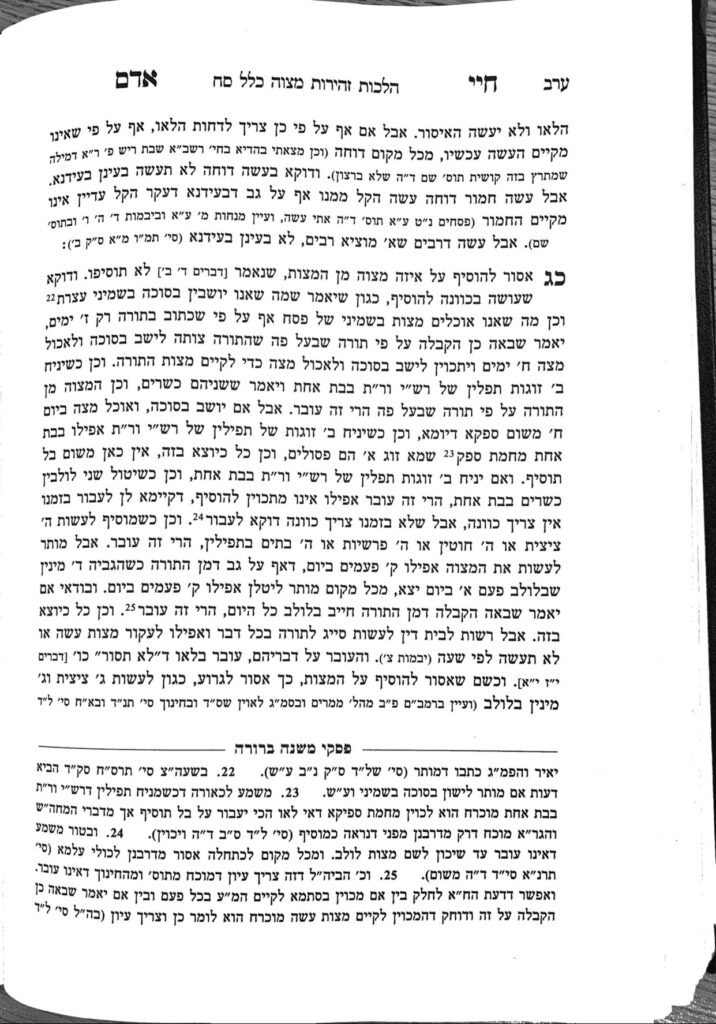We are continuing in siman 23, discussing the halachos of bal tosif. At the end of the siman, the Chayei Adam mentions two points in parentheses. First, he refers the learner to where the Rambam discusses these halachos. Second, he points out that although we learned (shiur 1473) that one transgresses bal tosif during the timeframe of a mitzvah even if they did not have intent for bal tosif, some hold that the person must have kavana in order to transgress bal tosif.
In the Encyclopedia Talmudis, under the entry of bal tosif, the authors point out the different types of bal tosif:
- An addition of time, such as sitting in the sukkah after Sukkos is over;
- An addition in repetition, such as blowing more tekiyos on Rosh Hashanah (which the rishonim discuss why it is muttar);
- An addition to the item, such as adding another species to the arba minim;
- Someone who is not chayav in the mitzvah, such as a woman performing a mitzvah which she is not chayav in. The consensus of the poskim is that there is no bal tosif in such a case.
- An addition of an entirely new mitzvah. It is clear that it is assur for an individual to add such a mitzvah, but it is not clear regarding bais din. We know that bais din added the mitzvah of mikra megillah, and the Gemara discusses at length their authority to do so.
We need to clarify an important point regarding sitting in the sukkah on Shemini Atzeres. In Eretz Yisroel, it is clearly assur to sit in the sukkah on Shemini Atzeres, due to bal tosif. On the other hand, the Gemara already discusses a person who wishes to sit in the sukkah because it is more comfortable. The Gemara says that the person must do something to make it clear that they are not sitting in the sukkah for the purpose of fulfilling a mitzvah. The Gemara explains that during Sukkos, a person is not supposed to bring the pots in which the food was cooked into the sukkah. (There is a shitah that while the pots are in the sukkah, the sukkah is not kosher, but we do not pasken like that shitah. It is assur but does not invalidate the sukkah) Thus, in order to demonstrate that they are not sitting in the sukkah for the purpose of fulfilling a mitzvah, they should bring their pots into the sukkah with them.
In Chutz La’aretz, one is chayav in sit in the sukkah on Shemini Atzeres due to the safeika d’yoma. One does not make a bracha on a safeik, out of concern that it may be a bracha levatala. We use that halacha to indicate that we are not sitting in the sukkah for the purpose of adding another day to Sukkos, but rather due to the safeik, by abstaining from reciting a bracha on the sukkah. By not reciting the bracha, we are demonstrating that we are not in the sukkah due to a new mitzvah (which would necessitate a bracha). However, this suggestion does not help when one is sitting in the sukkah in a situation in which they do not make a bracha anyways, such as when sleeping in the sukkah, or eating foods which are patur from the bracha.
Some have the minhag to only eat in the sukkah during Shemini Atzeres day, and to eat at home on Shemini Atzeres evening. This minhag came into place as a way to make a clear distinction that the purpose of sitting in the sukkah on Shemini Atzeres is not because it is an additional mitzvah, for if it were, they would sit in the sukkah on Shemini Atzeres evening as well.
The Mishnah Berurah points out that, although there may be a logic behind this minhag, it goes against the Gemara which states one should sit in the sukkah on Shemini Atzeres evening as well, due to this sfeika d’yoma. Therefore, the Mishnah Berurah paskens that one should sit in the sukkah on Shemini Atzeres evening, but should not sleep in the sukkah overnight in order to show a differentiation between Shemini Atzeres and the other days of Sukkos. Nevertheless, the Gra paskens that one should still sleep in the sukkah on Shemini Atzeres night, because, on the safeik that they are chayav, it is part of the mitzvah as well.
Summary
The potential different forms of bal tosif are:
- An addition of time, such as sitting in the sukkah after Sukkos is over;
- An addition in repetition, such as blowing more tekiyos on Rosh Hashanah;
- An addition to the item, such as adding another species to the arba minim;
- Someone who is not chayav in the mitzvah. The consensus of the poskim is that there is no bal tosif in such a case.
- An addition of an entirely new mitzvah.
We demonstrate that one is not sitting in the sukkah on Shemini Atzeres for the purpose of a new mitzvah, but due to the sfeika d’yoma, by not making a bracha on the sukkah.



